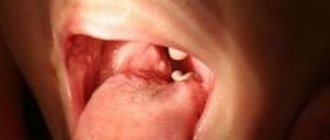A cold and a sore throat are two things that go hand in hand. When you have a cold, you feel an unpleasant sore throat (soreness, pain when swallowing). Although the sore throat with a cold is milder than with the flu, it will still have to be treated.
It is very easy to get a cold in your throat, everyone knows about it. It is enough to drink something cold or freeze. A cold in the throat will make itself felt. Not everyone's cold starts with a sore throat. Someone may have a stuffy nose or feel very weak and drowsy. Regardless of how the cold started, the main thing is to start treatment on time. To do this, you need to know the symptoms of a cold and distinguish them from flu symptoms.
Cold symptoms
The symptoms of a cold sore throat are different from the symptoms of the flu. For example, with a cold there is no high fever. It can rise to 37.5 degrees. High temperature (above 38 degrees) and fever are characteristic of the flu. A runny nose and sneezing are symptoms of a cold. A sore throat with a cold is moderate; the flu is characterized by a severe sore throat.
Everyone knows that the flu causes very severe weakness, which can last up to two weeks. With a cold, weakness is not very strong. However, bed rest must be observed. Often people suffer from colds “on their feet”, which leads to complications. The most striking of them are sinusitis and otitis media. In addition, a person infects others if he leaves the house with a cold in his throat. If you care about your health, think about other people. Your team will not thank you if a good half of it gets sick. Try to take sick leave or ask your boss for at least a couple of days off. On the way home, be sure to buy more citrus fruits: lemons, oranges, tangerines. You will need them for a speedy recovery.
Herbal gargles
For sore throats, herbal tinctures are in great demand. You can make a throat infusion from:
- chamomile, calendula and eucalyptus;
- calendula, plantain and wormwood;
- fragrant violets and plantain;
- sage, mallow and elderberry flowers.
The easiest option is to gargle with chamomile or calendula. You can also gargle with linden decoction, which relieves inflammation well. Gargling with oak bark will help destroy all dangerous microorganisms. Here the choice of rinse depends on the person.
Colds and sore throat
If you have a cold and sore throat, then most likely it is pharyngitis. It cannot be treated with antibiotics. You will only make things worse. You will not cure your throat in one day, but will acquire additional diseases. The fact is that a cold sore throat is caused by viruses, not bacteria. Antibiotics kill bacteria, not viruses. Therefore, it is best to treat a cold without the help of pills and medications. The only thing you can buy at the pharmacy is lozenges for sore throat. These lollipops contain phenol. This component helps curb the spread of infection. In addition, the lollipops slightly freeze the nerve endings in the throat, and the pain decreases.
One of the proven remedies for a cold throat is inhalation. A vegetable like potatoes is almost always in the house. And if you unexpectedly catch a cold, you can take inhalations with boiled potatoes.
To do this, you need to wash the potatoes and boil them together with the peel. Then mash in a saucepan. Sit at the table and lean over the saucepan. It is best to cover yourself with a towel on top. So you need to breathe over the vapors of the potatoes until it cools down. At the beginning of the procedure, be careful not to cover yourself with a towel, you can burn your face with hot steam!
Ginger tea will relieve a sore throat. Ginger root is truly an amazing medicine. It has antiseptic, antibacterial properties. How to make ginger tea for a cold throat? Very simple. You need to pour a glass of boiling water, cut the ginger root into thin slices, about 3-5 centimeters. When it cools down a little, you can add honey and lemon. Drink in small sips. By the way, this tea can also be brewed for children with a cold in the throat. In this case, a few pieces of ginger are enough. If the child refuses to drink such a drink, you can dilute the tea a little more by adding boiling water.
Treatment options
Despite the fact that every second resident experiences a cold every year, few know how to properly treat a sore throat for a cold. In this case, comprehensive treatment of colds will be optimal. To eliminate inflammation, relieve swelling and sore throat, you will need several remedies:
- Compliance with home regime. During the period of illness, it is better to stay at home for 2-3 days, since temperature changes and hypothermia will only aggravate the patient’s condition;
- Drink plenty of fluids. If you have a cold, you should drink at least 2 liters of liquid per day. Warm drinks, broths and soups will help remove toxins from the body that increase the inflammatory process;
- Rinse. Gargling with antiseptic solutions (propolis, calendula, miramistin or sea water) and decoctions of medicinal herbs will reduce pain and swelling in the throat. The procedure must be performed every 2-3 hours;
- Antiseptic sprays. Antibacterial solutions with a spray better penetrate the mucous membrane of the throat, helping to destroy pathogenic microflora. Hexoral, Jox and their analogues are effective for sore throat;
- Airing the room. The flow of fresh air has a beneficial effect on the mucous membrane of the throat, promoting a speedy recovery. But at the time of ventilation, the patient should leave the room to avoid hypothermia;
- Avoid eating spicy, too hot or cold food and drinks, which will more irritate a sore throat;
- If, along with a sore throat, you develop hoarseness in your voice, then you should not speak even in a whisper for several days.
And although it is quite possible to treat a sore throat with a cold on your own, a doctor’s help in this matter will not be superfluous.
The following video provides a recipe for milk with turmeric and ginger for a sore throat due to a cold:
If you experience a sore throat, runny nose or other symptoms associated with a cold, you should consult your doctor.
How to gargle for a cold?
Gargling is considered the most effective remedy for a cold throat. A popular rinse recipe is to dilute 1 teaspoon of salt, 1 teaspoon of soda in a glass of water and add a couple of drops of iodine. This solution acts in three directions. Salt draws out and kills bacteria, soda softens inflammation, and iodine saturates the throat and helps the immune system cope with the disease faster.
What to gargle with when you have a cold other than this?
- Lemon juice. To relieve inflammation, you can gargle with lemon juice diluted in a glass of warm water. Lemon will soothe the pain, and the natural essential oils contained in the juice will block the spread of infection.
- Furacilin. This remedy can be used when your throat hurts due to a cold. Furacilin tablets have disinfectant properties. They will help relieve inflammation. At the first sign of a sore throat (soreness), you need to make the following solution. Take 1-2 tablets of furatsilin and dilute them in warm boiled water. Stir thoroughly and gargle every hour. Then the virus will have no chance to travel lower into the lungs.
- Chamomile decoction. Chamomile comes to the rescue with the question of how to gargle for a cold. This natural antiseptic will neutralize infection, relieve pain and soothe the throat. To make a chamomile decoction for rinsing, you need to take 1 tablespoon of dried chamomile flowers and pour 1 cup of boiling water. Then insist. When the broth becomes warm, you can rinse without filtering. This decoction is best used as an alternation when gargling with other means.
- A decoction of various herbs. You can make a medicinal decoction for gargling with medicinal plants such as eucalyptus, chamomile and calendula. Take these herbs in equal proportions and mix thoroughly. Then take 1 tablespoon and pour 1 glass of boiling water. Let it cool until it cools down, filter it and start gargling.
- The drug chlorophyllipt for a cold throat. You need to take a 1% solution of chlorophyllipt. A solution of this medicine can be purchased at a pharmacy. It is sold in liquid or spray form. Chlorophyllipt helps with sore throat, laryngitis and severe colds in the throat.
- The drug Miramistin. This product is available in two forms: spray and solution. It is worth considering that Miramistin is a very powerful remedy for treating the throat. Many even refuse to use it, explaining their decision by the fact that miramistin kills all bacteria, both good and bad. Before using this remedy, you should definitely consult a therapist. You need to know in what concentration to use it in your case.
It is important to remember that bacteria today adapt very quickly to different types of treatment. Therefore, it is important to alternate the use of certain drugs, preventing the infection from getting used to them. The doctor will tell you what is the best means to use.
Very often, a common cold in the throat develops into a sore throat. At the same time, cold symptoms intensify. The temperature rises, the head begins to hurt, the throat becomes red, white plaque and ulcers appear on the tonsils. Seeing a doctor is inevitable. Only a therapist can make the correct diagnosis and prescribe antibiotics. You yourself will not be able to determine whether the use of antibacterial drugs is necessary or not. Symptoms manifest differently in each person. Therefore, what helped one may harm another. You shouldn’t listen to word of mouth and apply everything on yourself. Rely only on qualified assistance.
What not to gargle when it hurts
On average, any person feels a sore throat about 2-3 times a year. The main cause of such discomfort in many cases is infection. In total, there are more than 300 bacteria that cause sore throat, of which 200 are viruses.
In 85-95% of cases, a painful symptom in the throat is associated with a virus. In other cases, the cause of pain is bacteria, and sometimes fungi.
With a sore throat, swelling of the throat, sore throat, enlarged tonsils and other unpleasant sensations are observed. The main goal of treatment is to eliminate pain, soreness during swallowing, dry cough and irritation of the nasopharynx. Patients should take antiseptics, follow a gentle diet, apply compresses to the neck and use medications to gargle. Not all doctors are clear about gargling.
The mucus that covers the lining of the pharynx performs many different functions: it protects the epithelium from harmful factors and bacteria, and also preserves immunocompetent cells. With constant rinsing with too concentrated solutions, mucus is washed out, and this in turn breaks the protective barrier of the mucous membrane.
Where does a cold come from?
A cold is not caused by cold, as its name might suggest. Typically, a cold is a viral infection, something that is referred to in the cards as ARVI.
There are a huge number of viruses around us that cause similar symptoms. Viruses spread through the air or touch Common cold in places where many people gather: in transport, offices, schools. When germs enter the body, our immune system responds to the attack and produces antibodies - protective proteins that kill the virus. This takes several days, from three to ten, and then the immune system destroys the microbe.
Viruses spread during the cold season, and it is not known exactly why this happens. There is a theory that at low temperatures our immunity weakens and is less able to repel virus attacks. Can Being Cold Really Make You Sick? . This means that it is not the forgotten hat that is to blame for a cold, but the body’s unpreparedness to fight germs.
By the way, influenza also belongs to the “cold” ARVI, but it is a much more complex and dangerous virus. Lifehacker has already written about how to deal with it.
Cheap remedy for sore throat
Not everyone can afford to purchase drugs from popular brands. However, even with fairly modest money you can purchase an effective medicine that will help relieve inflammation and improve a person’s well-being.
Budget pharmaceuticals include:
One of the most accessible antiseptic drugs, the active ingredient of which is decamethoxin. It is active against most microorganisms, including those resistant to penicillins. It also exhibits fungicidal properties and increases the susceptibility of bacteria to the action of antibiotics. Septefril is produced in the form of tablets that must be dissolved in the mouth.
A long-known antibacterial medicine based on sulfonamide. It stops the process of bacterial cell division, but is not able to suppress the vital processes of anaerobic microbes and viruses. Streptocide is taken orally with plenty of water.
Yellow tablets intended for dissolving in warm water and gargling with the resulting solution. Furacilin has a strong antiseptic effect and is approved for use by pregnant women.
Its great advantage is considered to be almost 100% washing of the inflamed areas of the mucous membrane, due to which it is possible to destroy the maximum number of pathogen cells. Furacilin also increases local immunity and is ideal for combating chronic pathologies, especially chronic tonsillitis, in the acute stage.
A local antiseptic with a broad spectrum of action, the main active substance of which is iodine. It must be applied with a tampon to the affected mucous membranes several times a day, which may be accompanied by significant discomfort and the urge to vomit.
Contains camphor, eucalyptus oil, chlorobutanol and levomenthol. It exhibits antiseptic properties, effectively eliminates swelling of the mucous membranes and pain.
An aerosol whose active components are essential oils of eucalyptus and peppermint, streptocide, and norsulfazole. It can be used to treat infections of any nature, but due to the characteristics of its composition, it is often poorly tolerated by allergic patients.
With the help of these affordable and reliable medications, in most cases you can overcome the infection and achieve a full recovery.
How to treat a cold
Colds actually go away on their own in about a week once antibodies appear. But we can help the body cope with the disease more easily.
Stay home and relax
Of course, we are very busy and cannot afford to relax because of a runny nose. But the body is also very busy: it is overwhelmed with the fight against viruses. And his deadline is more important.
Bed rest is just what you need when you feel unwell.
Additionally, respiratory viruses (those that infect the respiratory system) are highly contagious. If you have the strength to go to work or study even when sick, then think that you can transmit the virus to a weakened person. And it will not be so easy for him to cope with a cold.
Drink more fluids
This is not “drink eight glasses a day” advice. Liquids are really needed when you have a cold. Dried fruit compote or warm tea helps cope with unpleasant symptoms. You should drink 3-5 cups more per day than when you are healthy.
When there is enough fluid in the body, it is easier for all mucous membranes (which suffer most from the effects of viruses) to work. When a person is sick and drinks a lot, he easily produces phlegm from his lungs and mucus from his nose, which means that viral particles do not linger in the body.
When you have a fever, the body loses a lot of moisture, so a high temperature is also a reason to drink a cup of tea.
You can add herbal decoctions to tea: chamomile, linden, sage. They help alleviate cold symptoms and bring at least some variety to the tea menu.
Use nasal drops
Nasal drops are different, because a runny nose is different.
- Salt water drops . Saline solution 0.9% is a good way to moisturize the mucous membrane. It will help to gently rinse your nose and remove mucus. Some manufacturers offer sea water, but in general you can use regular saline solution, which is sold in a pharmacy: it is cheaper. You can also prepare salt water at home. To do this, a teaspoon of salt must be dissolved in one liter of water. You can instill such water often, every half hour. Then you will really feel the full power of a simple remedy.
- Oil drops . They help when the nose is not stuffy. They moisturize the mucous membranes and make breathing easier.
- Vasoconstrictor drops . They remove swelling of the nose, which makes it impossible to breathe. Such drops should be used with caution: do not use them for more than five days, so as not to cause addiction, do not exceed the dosage specified in the instructions, so as not to provoke poisoning with the active substance (this is especially important for children).
Help your throat
A sore throat is best helped by gentle therapy: warm tea in small sips, warm gargling, lozenges.
It is better to gargle with something that feels good to you. For example, the same herbal decoctions: chamomile or calendula.
Do not force yourself to make elixirs from iodine, soda or aloe with kerosene.
The purpose of rinsing is to relieve pain and swallowing, and not to destroy all living things. The virus still cannot be washed off this way.
Use painkillers
When you just have a headache, don’t force yourself to suffer and take ibuprofen or paracetamol based remedies.
Let the temperature work
Reduce the temperature above 38.5 °C. Before this figure, it is better not to fight fever, because it is needed to destroy viruses. Of course, if you feel unwell, it is better to help yourself with painkillers and antipyretics.
Ventilate your rooms and take a walk
A draft and fresh air from a window will not cause deterioration. On the contrary, they will help. Ventilation is a way to clean the air in a room from germs, the simplest and most accessible method of disinfection.
Quiet walks in the fresh air also help you feel better, but you should not walk in a shopping center, but in a park or at least an alley where there are not many people.
Of course, walking is a remedy for when you feel more or less normal or are already recovering.
Treatment of sore throat and rhinorrhea
Rhinitis, sore throat and pain can be cured through symptomatic and systemic therapy. If the cause of the disease is a viral infection, the doctor prescribes the following to the patient:
- antiviral medicine;
- antipyretic, anti-inflammatory drug;
- nasal drops based on saline solution to moisturize the mucous membrane;
- nasal drops with a vasoconstrictor effect.
Only a doctor can prescribe any medication.
If the cause of the disease is bacterial infection or there is a risk of complications, the patient is prescribed antibiotic drugs for sore throat. You should also consider taking an antibiotic if the temperature exceeds 38 degrees Celsius.
Diseases for which antibiotics are used include: pharyngitis, meningitis, tonsillitis, and the like. If the patient notices that the nasal mucus has acquired a yellow or green color and something like distension is felt in the wings of the nose and in the forehead, then you should not postpone a visit to the otolaryngologist.
A change in the color of snot may be evidence of the attachment of an infectious pathogen and the formation of purulent masses. Similar symptoms, together with a sharp jump in temperature, are inherent in frontal sinusitis or sinusitis.
How not to treat a cold
It turns out that the cold goes away on its own and there is no need to treat it. But it’s hard to accept, you want to do something as quickly as possible and somehow influence the body - shouldn’t you sit idly by? But this is exactly what needs to be done. For colds, care and regimen are the treatment; their importance should not be underestimated.
When your hands reach for the first aid kit, remember what not to do:
- Take antibiotics . Antibiotics only act on bacteria and do not kill viruses. Taking antibacterial drugs without indications is dangerous: you can get a bunch of side effects and grow a superbug on yourself that will not respond to treatment. Lifehacker has already written about this in detail.
- Buy antiviral agents and immunomodulators at the pharmacy . They have no proven effectiveness, 100% only work to empty wallets. The same applies to homeopathy.
- Putting mustard plasters on and soaring your feet . What grandmothers and parents love so much is too dangerous: there is a high risk of getting burned by hot water or mustard. These procedures do not destroy viruses. I’ll tell you a secret that in medical colleges they are held within the framework of the topic “Distractive procedures” so that the patient feels cared for and thinks less about the disease.
- Drink vitamins by the handful . Especially vitamin C. It was once thought to help with colds. This is not true 5 Tips: Natural Products for the Flu and Colds: What Does the Science Say? , but old beliefs live long.
Symptoms with pain during a cold
It would seem that the painful condition is obvious, but, as it turns out, there are certain symptoms with a sore throat during a cold. These most often include:
- Headaches and migraines.
- Fever.
- Increased lacrimation.
- Runny nose. Initially, slight transparent discharge from the nasal cavity, followed by thickening and acquiring a green tint.
- Weak cough.
- Intermittent muscle pain or “bone aches.”
Such a cold must be treated as soon as possible, since it will not bring anything good other than complications.
Sore throat, dryness due to cold
A sore throat or dryness during a cold will not appear out of nowhere. The most common cause of this condition is a viral infection. With timely treatment, it goes away almost unnoticed. But, pharyngitis has appeared. It seems to cut the throat and creates special discomfort. Even drinking plenty of water doesn't help at all. It only temporarily relieves symptoms. And after half an hour I am again tormented by a sore throat and a feeling of severe discomfort.
Cold, cough, sore throat
In this case, the disease began to progress and additional factors were added to the common cold. Colds, coughs, and sore throats can cause the development of acute respiratory infections. On the 3-4th day of the disease, fever and weakness may appear. Often similar symptoms accompany laryngitis.
Severe sore throat with a cold
Do not assume that a severe sore throat during a cold is only an isolated sign of the disease. Most often, severe pain and fever with difficulty swallowing functions appear due to sore throat. In this case, the throat is red, the tonsils swell, and point inflammation with ulcerations appears. In this case, you need to immediately contact a specialist. By triggering such a cold, and also a viral disease, you can provoke serious complications, which in the future will lead to serious health problems.
When to ask for help
More serious illnesses can be hidden behind the mask of a cold. Be sure to seek medical help if:
- The symptoms have not gone away for three weeks.
- Some symptom has become very strong or causes pain.
- It became difficult to breathe.
- There was pain in the chest.
Sore throat is the most common complaint when visiting a general practitioner or ENT doctor. So common that patients no longer take it seriously. But in vain: ignoring the symptoms can lead to the development of serious complications even with a mild cold. In order not to fall out of life for a long time, it is necessary to correctly determine the cause of a sore throat and know what measures can be taken. We'll talk about this in the article.
What products should you choose for gargling?
For a sore throat, you can use medicinal drugs, as well as standard folk remedies. Among the highest quality and proven means, the following can be distinguished:
- soda and saline solution with added iodine;
- vegetable juices;
- herbal infusions;
- furatsilin;
- Apple vinegar.
A solution of potassium permanganate is also often used to gargle. This rinsing method should be used with caution as it may cause burns to the mouth. The potassium permanganate solution dries out the mucous membrane, so after the procedure you should lubricate the throat with vegetable oil.
For a sore throat, gargling with apple cider vinegar is the best remedy. In order to make a solution, you should take a glass of boiled water and add a spoonful of vinegar.
Beetroot juice for sore throat helps relieve swelling, pain and inflammation. You can gargle with this product every 3 hours. No less useful is a decoction of dried blueberries, which helps eliminate inflammation in the throat.
Causes of inflammatory processes
Many people associate the cold season with outbreaks of infectious diseases and an increased likelihood of falling home sick. And indeed: hypothermia, reduced immunity and vitamin deficiency, which are characteristic of this time, significantly undermine the protective functions of the body. But in fact, infections are far from the only cause of inflammation in the throat. Let's look at the main ones.
Infectious diseases of various etiologies are the most common cause of pain. They can be caused by bacteria, viruses and even fungi. The causative agent and localization of the infectious process influence the characteristics of the clinical picture and approaches to treatment.
- ARVI (acute respiratory viral infection) is a wide group of clinically and morphologically similar diseases caused by viruses. The most common pathogens of ARVI are: rhinovirus, adenovirus, influenza virus, parainfluenza and others - more than 200 variants in total. An adult experiences one of the forms of ARVI about two or three times a year. Depending on the pathogen and the characteristics of the immune system, the clinical picture may vary somewhat, but the main signs remain inflammation of the throat mucosa with catarrhal symptoms (redness, pain and sore throat, runny nose, coughing, sneezing), as well as weakness, fever, and headache.
On a note
ARVI accounts for more than 90% of all infectious diseases [1]. Every year, up to 41.2 million cases of ARVI are registered in Russia. They are the cause of almost 40% of incapacity for work on sick leave for workers [2].
- Pharyngitis is an inflammatory disease of the pharynx that occurs under the influence of viral, bacterial (streptococcus, staphylococcus) and fungal (candida) infections. The development of pharyngitis is also influenced by unfavorable climatic factors, inhalation of polluted air, injuries and allergies. The clinical picture of pharyngitis includes intense hyperemia (redness) of the pharyngeal mucosa, pain and sore throat, cough, and low-grade fever. There are acute and chronic courses. The chronic form develops after an untreated acute form, due to frequent infectious and inflammatory diseases, smoking and poor environmental conditions. The symptoms of chronic pharyngitis are more smoothed out, but during exacerbations they become the same as in the acute form.
- Tonsillitis is an infectious and inflammatory disease of the pharyngeal tonsils. The main cause is bacteria, but viral and fungal pathogens also occur. There is an acute onset with severe pain in the throat, aggravated by swallowing. The process is limited to the lacunae of the tonsils or spreads to the lymphoid and other surrounding tissues. Affected tonsils have a loose appearance with purulent plugs. Lymphadenitis and signs of intoxication may occur. An untreated acute form sometimes becomes chronic and can cause serious complications such as peritonsillar abscess, kidney disease, heart disease and collagenosis.
- Laryngitis is an inflammation of the larynx that occurs against the background of colds and infectious diseases, hypothermia, polluted air or overstrain of the larynx. In the clinic, inflammation of the laryngeal mucosa is severe, hyperemia and tissue infiltration are visible. All this is accompanied by soreness, dry throat, debilitating “barking” cough, hoarseness, and signs of intoxication.
It is important!
Due to anatomical features, young children may develop a dangerous variant of laryngitis - false croup. This is an obstructive form that requires emergency hospitalization of the child, not in the ENT department, but in the intensive care unit or intensive care unit [3]. Due to severe swelling, the lumen of the larynx is greatly narrowed, which leads to severe difficulty breathing. It is necessary to immediately take the child to the hospital or call emergency services.
- Tracheitis is an inflammatory process in the trachea. The etiology is the same as for previous diseases. Often combined with laryngitis (laryngotracheitis). A paroxysmal cough (usually dry) occurs, especially with deep inhalations and exhalations, which prevents you from breathing “fully.” Other symptoms are also observed: pain in the throat, chest and muscles, voice loss, fever, and so on.
Tumor diseases of the pharynx and larynx develop gradually and may not make themselves felt at first. As the tumor grows, sensations arise that can be confused with symptoms of infectious diseases: changes in the timbre of the voice, discomfort when swallowing (especially solid food), sore throat, hemoptysis, difficulty breathing. You need to know that with colds, these manifestations rarely last more than two weeks. In any case, you should not delay a visit to the doctor, but if you decide to treat yourself, and the symptoms have lasted for three or more weeks, then you need to see a specialist urgently. Common symptoms include weakness, malaise, and weight loss.
Stomatitis is a common infectious and inflammatory disease of the oral mucosa, which often occurs against the background of reduced immunity, poor hygiene, accidental injuries when eating, or wearing low-quality dentures. Depending on the nature of the damaging factor, viral, bacterial, fungal and chemical stomatitis are distinguished. Redness, pustules, blisters, plaques and erosions appear on the mucous membrane. Typically, foci of stomatitis are localized on the inside of the lips, cheeks and under the tongue, but the process can spread to the palate and tonsils. All this is accompanied by painful sensations. Systemic phenomena are usually not observed.
Causes
The throat hurts, snot appears, the body temperature has risen to 37.5 degrees or higher - all these symptoms indicate an infectious infection.
If the immune system is strong, then the body is able to resist viruses, but if immunity is low, then the ingress of any pathogenic agent, bacteria or allergens can provoke the development of an acute reaction, causing catarrhal symptoms, which are characteristic of colds.
Rhinorrhea without an increase in body temperature, as well as pain in the throat, can be the result of exposure to other causes that are not associated with viral infection. This condition can be caused by:
- Presence of nasal septum defects.
- Nasal abnormality.
- Smoking habit.
- Sudden change in temperature.
- Dry air in the living room.
- Hormone imbalance.
- Disorder associated with neuralgia.
- The body's reaction to an allergen.
The above factors irritate the nasal mucosa, causing tissue swelling and inflammation. Such disorders can cause frequent bouts of sneezing, tearing, itching, and copious mucous discharge from the nasal cavity.
If you experience rhinitis, pain in the throat, or increased body temperature, the likely cause may be a virus or pathogenic bacteria entering the nasopharynx. With such an infection, the clinical manifestations will be severe.
They will be accompanied by headaches, general intoxication of the body, fever, and possible nausea and vomiting. Eighty percent of such cases are acute catarrhal symptoms caused by the influenza virus, enterovirus, and rhinovirus. After they enter the mucous membrane, tissue swelling and inflammation appear.
If your throat hurts, but there is no snot and no fever, then this may indicate excessive consumption of too hot food or diseases associated with the oral cavity.










